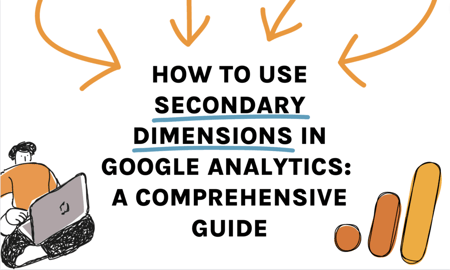Grasping Secondary Dimensions in Google Analytics: Their Importance and Reliable Usage
Grasping Secondary Dimensions in Google Analytics: Their Importance and Reliable Usage
Blog Article
Introducing the Effect of Second Dimension in Google Analytics on Information Evaluation and Insights
In the world of data analytics, the usage of second dimensions within Google Analytics has actually arised as a pivotal tool for extracting much deeper insights and unraveling complex patterns that might otherwise stay covered. By peeling off back the layers of key data sets, additional dimensions supply a nuanced viewpoint that enhances the understanding of user behavior, website performance, and the effectiveness of marketing methods.
Discovering the Principle of Additional Dimensions
Second measurements in Google Analytics give extra understandings by allowing individuals to analyze primary information in conjunction with a secondary attribute. By including additional measurements, users can delve much deeper into the information and reveal important connections that might or else go unnoticed - what is a secondary dimension in google analytics.
By discovering the numerous secondary dimensions available in Google Analytics, individuals can unlock brand-new understandings and optimize their electronic advertising efforts. In essence, additional dimensions serve as a powerful tool for enhancing information evaluation and driving workable outcomes.
Enhancing Data Analysis With Secondary Dimensions
Having actually developed the foundational understanding of second measurements in Google Analytics and their pivotal function in information evaluation, the focus currently shifts towards leveraging these second credit to enhance the interpretation of analytics information (what is a secondary dimension in google analytics). By integrating secondary measurements into data evaluation, analysts can obtain much deeper understandings into user habits, site performance, and marketing performance

In addition, additional dimensions aid in contextualizing key information metrics by supplying extra layers of information. This contextualization help in recognizing the 'why' behind the information patterns, helping experts make notified decisions and optimizations to enhance overall efficiency. Eventually, integrating secondary measurements enhances the information interpretation process, causing more calculated activities and meaningful understandings.
Revealing Hidden Insights Via Additional Dimensions
Checking out the midsts of analytics information with additional measurements exposes beneficial insights that would certainly or else stay obscured. By including secondary measurements in Google Analytics, companies can discover surprise patterns, trends, and relationships that offer a more detailed understanding of customer behavior and web site performance. These added layers of data enable experts to delve deeper right into the primary dimensions, such as website traffic sources or landing web pages, and gain a much more nuanced viewpoint on how different variables engage with each various other.
With making use of second dimensions, analysts can section and contrast data across different measurements, allowing them to determine details factors that influence individual interaction, conversion rates, and general success metrics. For instance, by coupling the key measurement of 'tool category' with the secondary dimension of 'age,' marketing professionals can pinpoint which age demographics choose accessing the web site with mobile gadgets versus desktop computers. This level of granularity empowers companies to make data-driven choices and enhance their methods for far better outcomes. Ultimately, discovering covert insights through second dimensions enhances the depth and precision of information analysis, bring about even more enlightened decision-making and enhanced performance end results.
Leveraging Second Dimensions for Actionable Analytics
Structure upon the understandings unveiled through additional dimensions in Google Analytics, businesses can currently harness this enriched data landscape to drive workable analytics and tactical decision-making. By leveraging secondary measurements, organizations can dive deeper right into their information to remove useful patterns, trends, and connections that might have formerly gone undetected. This deeper degree of analysis makes it possible for organizations to get a more detailed understanding of customer actions, project performance, and general site performance.
One key benefit of using second measurements for actionable analytics is the capability to sector data based upon particular criteria. This segmentation allows services to tailor their strategies and campaigns to different target market groups, causing more targeted and effective advertising and marketing initiatives - what is a secondary dimension in google analytics. Furthermore, secondary dimensions offer an even more all natural sight of individual communications, making it possible for businesses to optimize their website material, layout, and overall individual experience
Making Best Use Of Decision-Making With Second Measurements
To improve tactical decision-making in analytics, leveraging additional dimensions in Google Analytics can offer a much more nuanced point of view on user habits and campaign performance. By incorporating secondary measurements right into information evaluation, organizations can dive deeper right into the specifics of their web site visitors' interactions and engagement patterns. This added layer of details allows find for an extra comprehensive understanding of just how different variables, such as demographics, tools, or web traffic sources, influence vital performance signs.

Verdict
Finally, the usage of additional dimensions in Google Analytics plays a crucial duty in improving information analysis and revealing covert insights. By discovering this concept, one can get a deeper understanding of individual behavior and make educated decisions based upon workable analytics. Leveraging additional measurements permits an extra extensive analysis of data and takes full advantage of the performance of decision-making processes.

Report this page